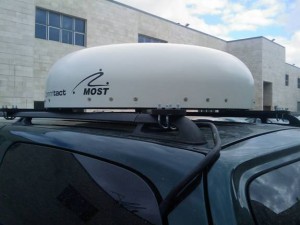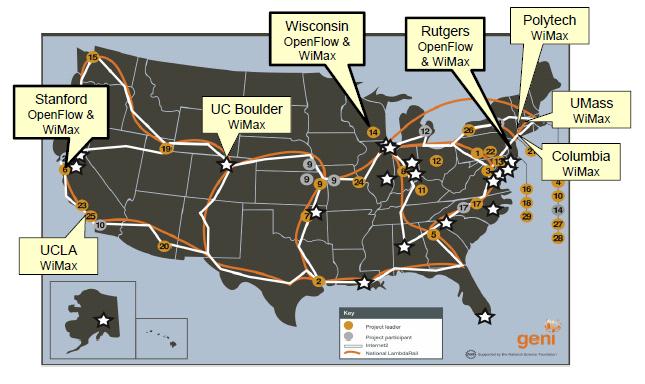Archive for the ‘Experimental’ Category
Sunday, February 14th, 2010
This summarizes a selection of applications for the Experimental Radio Service received by the FCC during February 8-12: mobile satellite terminals, white space, smart grid, satellite infrastructure, submarine communications.
- Xtreme Hi-Tech files an application (with supporting exhibits) for experimental license to test a new type of mobile satellite antenna while it is mounted on an SUV. Operation it to be on 14.0-14.5 GHz in suburban Washington DC. Photos accompanying the filing show a Commtact mobile satellite terminal, which Xtreme Hi-Tech sells.

(more…)
Posted in Antennas, Experimental, Infrastructure, Military, Satellite, Smart Grid, White Space | No Comments »
Thursday, February 11th, 2010
This describes a selection of applications for the Experimental Radio Service received by the FCC during January 30 through February 7: surveillance radar, airborne telemetry, mobile services, satellite, and amateur radio.
- Lockheed Martin filed an application (with supporting exhibit) for an experimental license to operate three models of ICx Radar System’s perimeter surveillance radar on 35.5 GHz for R&D and customer demonstrations. This will occur at various locations in the US, but primarily in Syracuse, New York.
- Honeywell filed an application (with supporting exhibits) for special temporary authority to operate in the 1625-1725 MHz range while integrating a new AeroVironment radio with an unmanned aerial vehicle used by the military. A key feature of the radio is that both command and control, as well as video downlink, can be accomplished using the same unit. Operation will be in New Mexico . There is concern about protecting the 1660.5-1668.4 MHz radio astronomy band, and discussions are ongoing.
(more…)
Posted in Amateur Radio, Experimental, Infrastructure, Mobile Services, Radar, Satellite, Telemetry | No Comments »
Saturday, January 30th, 2010
This summarizes a selection of applications for the Experimental Radio Service received by the FCC during January 25-29: radar, mobile broadband, auto-tracking antennas, millimeter wave, missile telemetry, astronomy research support.
- Powerwave, a wireless infrastructure vendor, files an application and supporting exhibits for experimental license to operate on 210-216 and 450-456 MHz in Santa Ana, California. The company wants to test operational and coverage aspects of Mobile Broadband Routable Internet (MBRI) users as they move about a campus setting. Hardware and software for handover, quality of service, and power control is to be tested.
(more…)
Posted in Ad-hoc Networks, Antennas, Experimental, Millimeter-wave, Radar, Telemetry | No Comments »
Tuesday, January 26th, 2010
This summarizes a selection of applications for Experimental Radio license, and for Special Temporary Authority, received by the FCC during January 21-25: radar, spacecraft telemetry, cognitive radio, modulation/demodulation techniques.
Raytheon Missile Systems files an application and supporting exhibit requesting Special Temporary Authority to use Freewave radios on an aircraft in support of a test to verify the accuracy and effectiveness of aircraft radar. The plan is to transmit the position information from the tracked aircraft to the tracking aircraft, and verify that the position information determined by the radar is in sync with the actual position of the tracked aircraft. (1.35-1.39 GHz)
(more…)
Posted in Cognitive Radio, Experimental, Modulation/Demodulation, Radar, Telemetry | No Comments »
Tuesday, January 26th, 2010
This summarizes a selection of applications for Experimental Radio license, and for Special Temporary Authority, received by the FCC during January 14-20: VSAT for Haiti, helicopter surveillance in Chicago, WiMAX, wideband at high frequencies, avionics, cell phone jamming, and radar.
(more…)
Posted in Antennas, Engineering, Experimental, Jamming, Radar, Satellite, WiMAX | No Comments »
Sunday, January 17th, 2010
This is a summary of experimental radio applications received by the FCC during January 11-13, 2010: unmanned aircraft, nuclear reactor communications, aerial surveillance, WiMAX, landslide monitoring, antenna testing, and more.
(more…)
Posted in Experimental | No Comments »
Sunday, January 10th, 2010
Companies request permission from the FCC to test cell phone jamming, antenna-induced interference, millimeter-wave transmission, RFID, radar, and remote-controlled streetlights.
(more…)
Posted in Antennas, Experimental, Jamming, M2M, Millimeter-wave, Radar, RFID | No Comments »
Sunday, December 27th, 2009
The University of Massachusetts has filed an application and supporting exhibit with the FCC for an experimental license to use WiMAX as part of the Global Environment for Network Innovations (GENI) project.
Operation will be at 2590-2600 MHz and use NEC’s WiMAX base-station hardware supporting a maximum of three sectors, a coverage radius of 3-5 km, and peak data rates of 15-30 Mbps. The base station uses an external PC controller that interfaces the base station to other parts of the GENI infrastructure.
GENI plans to support experimentation on shared heterogeneous infrastucture with programmability throughout the network, including wireless aspects. It is intended to promote innovations in network science, security, technologies, services, and applications. At this time, GENI plans to use WiMAX at 8 universities. Some sites will also use the OpenFlow standard, which allows researchers to run experimental protocols on production networks.

Posted in Experimental, WiMAX | No Comments »
Sunday, December 27th, 2009
BAE Systems has filed two applications with the FCC for experimental license. The first application and supporting exhibit is for testing, at 13.3 GHz, a re-design of BAE Systems’ ASN-128 Doppler navigation system used by the U.S. military. The re-design was needed because some materials used in the production of the antenna have been discontinued. Testing is to ensure that new materials have no adverse impact.
The second application and exhibit is to test, at 34.7 GHz, a radar collision avoidance system to be used by military aircraft, especially helicopters, at low altitudes to detect power lines and other structures that are close to the ground.
Posted in Experimental, Radar | No Comments »
Wednesday, December 23rd, 2009
General Dynamics submitted an application and supporting exhibit to the FCC to allow tests in support of the company’s Integrated Wireless Network, a nationwide trunked Land Mobile Radio system that is part of a government program. Various frequencies are requested including near 165, 770, and 800 MHz.
Posted in Experimental, Land Mobile | No Comments »
Wednesday, December 23rd, 2009
ADC Telecommunications has filed an application and supporting exhibit with the FCC requesting Special Temporary Authority to test a WiMAX (802.16e) pico base station in the 2.5 GHz range. Tested will be coverage, uplink communication, and throughput in the Greely, Colorado area. Testing is in conjunction with WiMAX operator Open Range Communications. ADC partnered with WiNetworks to design the base station.
Posted in Experimental, WiMAX | No Comments »
